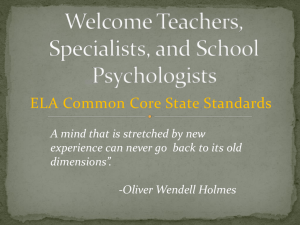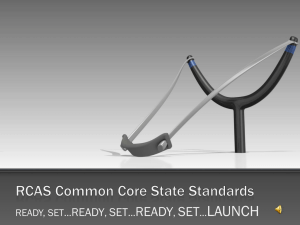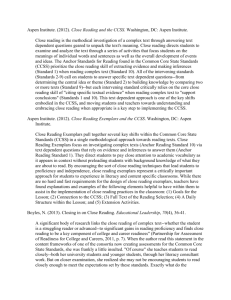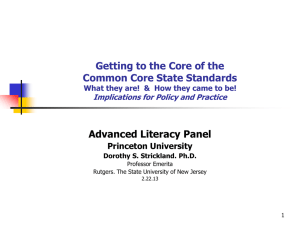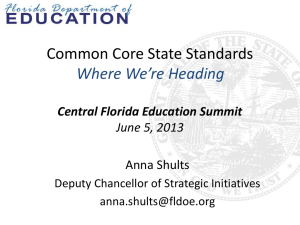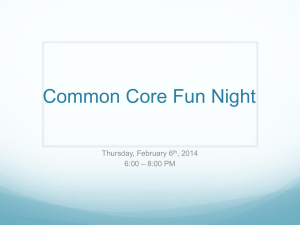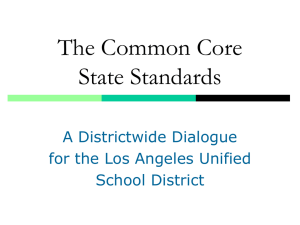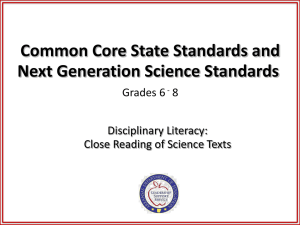Building Awareness of the Common Core
advertisement
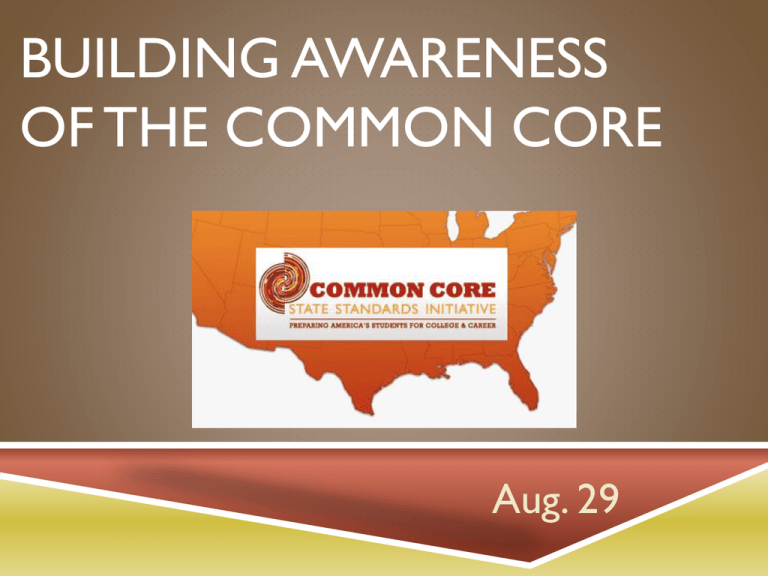
BUILDING AWARENESS OF THE COMMON CORE Aug. 29 PRE-VIEWING Teaching Channel videos showcase schools that have been piloting Common Core State Standards Elementary http://tinyurl.com/cxmezjs Middle http://tinyurl.com/cjz49kv High http://tinyurl.com/d5mt363 POINTS TO CONSIDER As you think about the closing of one school year and begin the transformation into another, file away just one number: 65 percent ….. …..fully 65 percent of today’s grade-school kids may end up doing work that hasn’t been invented yet. THINK ABOUT IT…. Think back 50 years…. could educators then have predicted the worldwide impact of the Internet, which emerged globally in 1994, or the mobile phone? These technologies have not just become tools of learning, but networking and knowledge sharing, as well as innovation and entrepreneurship…. From 60’s television to today's tools Remember the Star Trek Communicator….. …and now today we have the Smart Phone “The illiterate of the 21st century will not be those who cannot read and write, but those who cannot learn, unlearn, and relearn.” --Alvin Toffler BEYOND THE BUBBLE TESTS: THE NEXT GENERATION OF ASSESSMENTS “I am convinced that this new generation of state assessments will be an absolute gamechanger in public education.” --Education Secretary Arne Duncan September 2, 2010 AGENDA Overview Objectives CCSS vs. NGSSS CCSS Assessment examples Crosswalk Activity High Impact Anchor Literacy Strategies Process time Extended learning options Exit slip OBJECTIVES Teachers will be able to: increase their Knowledge of Content and Pedagogy (VSET 1A). locate the Common Core State Standards that apply to their courses. compare the level of rigor required by the CCSS with the level of rigor currently expected of students. OBJECTIVES Teachers will be able to: determine which of the CCSS they currently teach and at what level. understand that the CCSS do not just require new standards to be taught, but they also require teaching that requires students to think more deeply and at higher levels. apply the high impact anchor literacy strategy in their classrooms. participate in the extended learning options of their choice. TRANSITIONS TO COMMON CORE STATE STANDARDS NGSSS Standards-based instruction Test item specifications guide development of curriculum maps Focus mini-assessments aligned to CCSS Standards-based instruction facilitated by learning goals Big ideas and learning goals guide the development of curriculum maps individual benchmarks and used to Learning progressions or scales describe expectations for student monitor student progress progress in attaining the learning goals Teaching benchmarks in isolation results in long lists of tasks to master Assessments used to monitor student progress are aligned directly to the learning progressions or scales Teaching big ideas narrows the focus and allows students to delve deeper for a greater depth of understanding 11 CCSS AND PARCC ASSESSMENT EXAMPLES ELEMENTARY PARCC ASSESSMENT EXAMPLES MIDDLE SCHOOL PARCC ASSESSMENT EXAMPLES HIGH SCHOOL PARCC ASSESSMENT EXAMPLES COMMON CORE STATE STANDARDS Where to Locate CCSS: www.corestandards.org English Pdf Website Math Pdf Website All Other Subjects For Social Studies, Science, Technical Subject Areas, and All Others COMMON CORE STATE STANDARDS There’s an App for That! Name: Common Core App Download Info—click on button below Available for iPhone and Android Common Core App FLORIDA’S COMMON CORE STATE STANDARDS IMPLEMENTATION TIMELINE ANCHOR LITERACY STANDARDS College and Career Readiness Anchor Standards Required of all subject areas in K-12 Reading and Writing CROSSWALK ACTIVITY Instructions Break into homogeneous teams End with group debrief CLASSROOM CONNECTION District focus comes from high-impact anchor literacy strategies offered at state CCSS by Just Read Florida One Anchor Literacy Strategy will be incorporated into each professional development day Expectation is to use the highlighted strategy at least once each week between sessions THIS SESSION’S STRATEGY Make close reading and rereading of texts central to lessons. What does this mean? What does this mean for my content area? WHAT IS CLOSE READING? What good readers do to get the most meaning from complex text A process that entails reading and rereading multiple times, each time with a different purpose and focus Micro-reading: the attentive reading of a text A finely detailed, very specific examination of a text. WHAT IS CLOSE READING? May require breaking text into smaller segments for some students Short text: use entire text for a close read Longer text: select specific text segments for a close read; then, relate those segments to the whole work CLOSE READING HELPS STUDENTS TO: Understand the purpose in reading See ideas in a text as being interconnected Look for and understand systems of meaning Engage in a text while reading Get beyond “surface” reading or skimming Formulate questions and seek answers to the questions while reading VIDEO CLOSE READING AND RE-READING Thinking Tools REFLECTING ON NEW KNOWLEDGE 4A ON 1A What have you learned today about CCSS and NGSS? About the level of assessments? About the level of rigor and depth expected? About which items you already do well, need to teach more deeply, and need to incorporate into your teaching? About how you will incorporate this month’s anchor literacy strategy? EXTENDED LEARNING OPTIONS Resources/Tools PD360 Videos Quick Tips VIMS Newsletter Webinars Increase understanding of Standards-Referenced Grading and how to use Pinnacle Instruction Action Research Project Option (can be connected to PGP) ALL Extended Learning Options can be used as action steps for your PGP, no matter which component you choose to focus on EXIT SLIP How can you incorporate this session’s literacy strategy in your classroom next week? Which extended learning option sounds most intriguing to you? Respond to these questions on Edmodo
